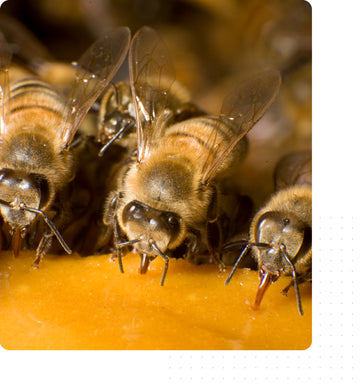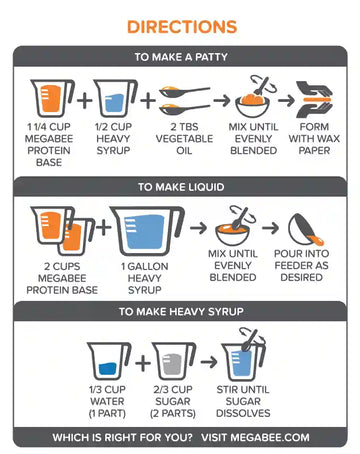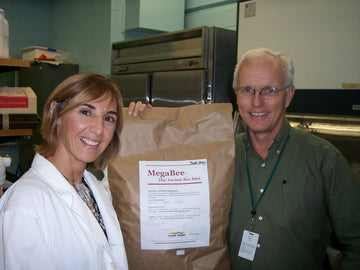Where did MegaBee get its start?
It began as a challenge
and revolutionized the industry.
It began as a challenge
and revolutionized the industry.
It began as a challenge
and revolutionized the industry.
"We need a new product - one that actually works"
"What about something that could be fed as a patty or a liquid?"
In 2000, MegaBee’s founder, Dr. Gordon Wardell, was approached by a group of beekeepers at the American Beekeeping Federation meetings and given the challenge of making a better food for bees. Ideally one that was versatile enough to be fed as a patty or mixed directly into sugar syrup. With a cooperative research agreement in place at the USDA ARS Carl Hayden bee research center in Tucson, they set out to create the perfect nutritional supplement for bees. It had everything the bees needed…but they wouldn’t touch it.
Turning to his team, Gordy said, “They have wings, we can't force them to eat something...so let’s ask the bees what they want.” This changed everything. His team ran palatability trials on dozens of different ingredients selecting ones they liked and refining the list, eventually selecting the best performing products and plugging them into a formula that balanced the delicate nutritional ratios honey bees need.
And MegaBee was born. The first high protein all-in-one product of its kind.
Since its launch in 2007, MegaBee has set the standard for premium honey bee nutrition. It has spurred an influx of premium pollen supplements around the globe as the beekeeping community increasingly implements supplemental feeding into hive management plans to deal with difficulties brought on by climate change, pesticides and parasites.

We let the bees
build it for us.
-
Highly preferred
Every ingredient was put through extensive
palatability trials to ensure the bees love them,
no tricking them with fake flavors or fillers. -
Rigorously tested
MegaBee has been independently tested in
some of the harshest environments in the world. -
Powerful results
Want to get the most out of your hives?
Then you gotta see the results for yourself.
PESTS, PARASITES, PATHOGENS & POOR PASTURE...OH MY!
With seemingly everything taking precious time off the bee's life,
our goal at MegaBee is to give them a fighting chance.
our goal at MegaBee is to give them a fighting chance.
Beekeeping is changing, we can all see it. Queens burn out faster than they used to. Pesticide use has skyrocketed in the last 15 years. Viruses, hive beetles, varroa...sometimes just keeping your hives alive feels like a win. But with MegaBee we can do more than survive, we can get those hives to THRIVE.
Our product's success lies in its ability to turn back the clock and transform the inner workings of the hive. The premise is this: What if a product could stimulate royal jelly production in nurse bees beyond what the brood needs? What would they do with the leftovers? Spolier alert: they share it! As that royal jelly gets passed around the hive it makes its way to the adult bees, field foragers that can no longer process traditional protein sources (like bee bread) and rely on carbohydrate sources until they burn out and join the "big hive in the sky."
When these field foragers start consuming royal jelly, protein levels in their bodies skyrocket and their lifespans are extended. Becuase of this house bees do not need to become field foragers quite yet. This massive trickle-down effect happens and bees can stay in their roles longer. The ratio of nurse bees to brood increases, ensuring healthy future generations. Longer living bees means more overlap between generations, leading to more bees in the box. More bees in the box = more honey, better pollination grades, fewer deadouts, etc.
Putting a little bit of time back on a single bee's life has massive implications for overcoming the challenges we see in today's beekeeping landscape. Our reserach, along with independent studies from some of the brightest minds in the industry shows this. Curious? Check out the reserach.
Mix, feed, split, repeat.
Easy mixing directions for small batches means making MegaBee couldn't be simpler! Need to feed a lot of hives?
-
For bulk batches of patties:
Mix equal parts heavy syrup & MegaBee powder + add 4% of the total batch weight in oil
-
For larger batches of liquid:
Mix up to 1LB of MegaBee for every 2 gallons of syrup
*ensure all clumps are broken up, syrup is true 2:1 heavy syrup, and mix WELL!

Frequently Asked Questions
In a nuc, new package, or struggling 1-box hive we would typically suggest starting out with half a patty (0.5LB). In an average sized hive, start with a 1LB patty and see how they do. In a very strong hive you might need 2-3 patties per hive…it all depends on their strength.
Think about this one. You go out and put beautiful fresh patties on your hives. The bees recognize them, start eating them and putting all that magical nutrition to work. The queen starts laying, nurse bees start producing tons of royal jelly and flood those immature cells with it. The brood loves it. They start giving off more and more brood pheromone – “feed me” becomes “FEEED ME.”
…and then you don’t put another patty on. The nutrition is used up and there isn't enough coming in naturally. What are they forced to do? When they recognize they have more immatures than they can feed they end up pulling out the brood.
The worst thing you can do is get your hive going strong and then shut off the tap. Keeping patties on for 4-6 weeks ensures plenty of time for brood to develop, turn into nurses, and then raise yet another crop of young healthy bees. That influx of young healthy workers jumpstarts your hive's growth and gives the bees what they need to turn things around in the hive.
When mixing for our hives, we like it a bit on the soft side, sort of resembling a firm pancake mixture. Some beekeepers like to make it to the consistency of cookie dough and form little balls before pressing between wax paper. The choice is yours…but trust us – once you get your mix down you’ll never buy pre-made patties again.
Side note: natural sugar is sucrose based and can be very drying. If you want a softer patty, you can always try using a bit of a fructose-based sugar in your mix to help balance out the sucrose.
If you struggle with hive beetles or the weather is warm and want to try something different, try mixing it directly into your syrup feeders or jars. MegaBee is one of the only products on the market that can be fed like this because of how fine we reduce the particle size down. Only tip with liquid feeding is to make sure you use a VERY heavy syrup (2:1 – 66brix or higher).
Candy boards are another great alternative! Many beekeepers use them in the winter to provide the bees with extra stores, when shipping bees long distances, or when unable to get back to hives for long periods of time. Candy can be made either into molds that are < 3/8” or pour directly into a hive cover as long as the sides are built up a bit. If it is winter and you don’t want the queen laying just keep the protein content under 5%. In the spring/summer/fall if you want to feed a high-protein candy get it over 5%. Interested in making candy? We have recipes here on the site for candy at 4% and 7%. Reach out to us for more information or look for the instructional videos here on the site (coming soon).
Some beekeepers will trap a little pollen during a heavy pollen flow and keep it for mixing into their patties. Studies have shown increased performance with little as 4% pollen added in, making it virtually indistinguishable from 100% pollen. Others will add old honey they want to use up to make patties instead of using heavy syrup. Feel free to try all sorts of things & if you ever have questions about adding a product to the mix and want to ask us, please don’t hesitate to reach out.
Beekeeping is population management. So if you are feeding and growing your hives just be sure to manage their space, flip boxes, adding a box when needed…typical hive management. We once gave a talk and a beekeeper in the back stood up and said, “I will never give that MegaBee stuff to my bees again.” When asked why he said, “because it made my bees swarm.” A groan went through the auditorium…it put too many bees in the box??
Most of the time it is an issue with the queen.
In many commercial operations, teams will put patties on every hive. When they come back and see a hive has not consumed their patty they mark it for closer inspection. In this way, patties can serve as a quick check to assess large numbers of hives and the same rule can be applied for yours.
Have a question that is not listed?
Click the button below to send us a message.

